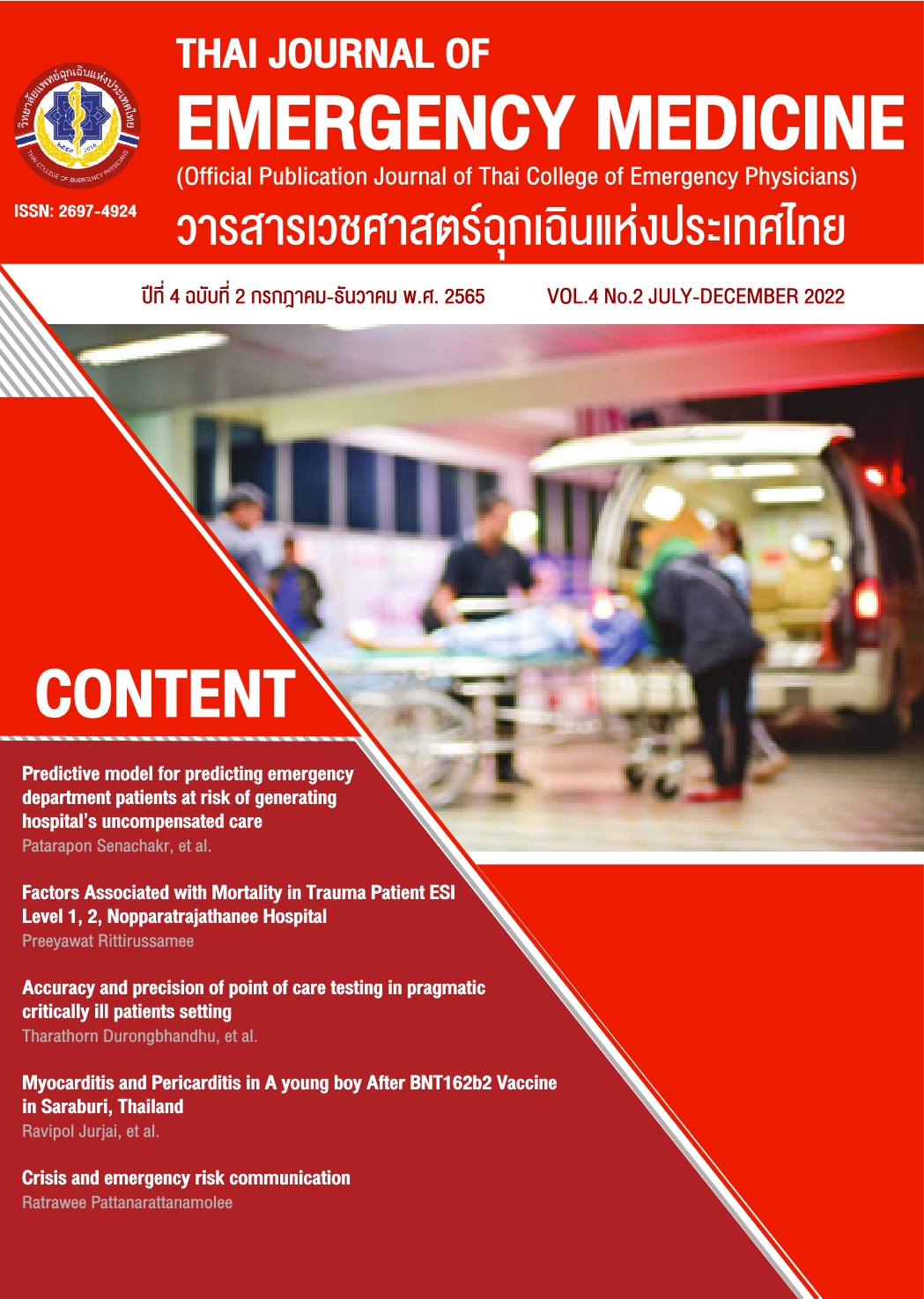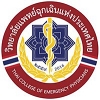Predictive model for predicting emergency department patients at risk of generating hospital’s uncompensated care
Keywords:
Uncompensated hospital care, charity care, predicting modelAbstract
Introduction
Some of patients create uncompensated hospital care. Many negative effects to hospital, patients and staffs occurred with uncompensated hospital care.
Objectives
For create predictive model for identifying patients who is at risk for uncompensated hospital care.
Method
This retrospective cohort study occurred in emergency department of King Chulalongkorn Memorial Hospital. Data was collected from electronic medical record from 1 Jun 2018 to 31 May 2020 and create predictive model.
Results
There were 93,753 patients included in this study. For multivariate analysis, risk of patients at risk of generating hospital’s uncompensated care are; age group 25-40 and 41-59 years are 1.38 times higher than that below 25 years, male patient is 1.46 times higher than female, patient who present on night shift is 1.21 higher than others, patient with universal health coverage(UC) other than Chulalongkorn hospital is 2.32 times higher and with self-pay is 2.28 times higher than Chulalongkorn hospital universal health coverage, government enterprise officer and social security fund, Asian and American patient is 1.28 and 1.62 times higher than others, patient who visit zone holding area, non-trauma, resuscitation and trauma is 3.25, 2.26, 2.52 and 1.65 times higher than urgent care. Predictive model for identifying patients who is at risk for uncompensated hospital care more than 1,000 Baht classified by risk score and optimal cut off value by Youden’s index is 20. So we divided patients in low risk group who’s risk score is 0-19, and high risk group who’s risk is more than or equal 20. Comparing high with low risk group OR 8.42 (6.77 – 10.5), sensitivity 76.7, specificity 71.9, PPV 4.3, NPV 99.5, AUC 0.74
Conclusion
Risk of patients at risk of generating hospital’s uncompensated care are age group 25-40 and 41-59 years, male, patient who present on night shift, Patient with patient with universal health coverage(UC) other than Chulalongkorn hospital and with self-pay, Asian and American and patient who visit zone other than urgent care. Predictive model for identifying patients who is at risk for uncompensated hospital care more than 1,000 Baht classified who’s risk score is more than 19 as high risk patient.
References
Atkinson G, Helms WD, Needleman J. State trends in hospital uncompensated care. Health affairs 1997;16(4):233-41.
Friedman E. Hospital uncompensated care:crisis?. Jama 1989;262(21):2975-77.
Camilleri S, Diebold J. Hospital uncompensated care and patient experience: An instrumental variable approach. Health serv res 2019;54:603-12.
Bristow RL. Uncompensated care. Jama 1986;255(6):796.
Zhang W. Uncompensated care for children without insurance or from low-income families in a chinese children’s hospital. Med sci monit 2014;20:1162-7.
Chen J, Brien MO. Latino population growth and hospital uncompensated care in california. Am j public health 2015;105(8):1710–1717.
Kilpatrick KE. Uncompensated care provided by private practice physicians in florida. Health serv res 1991;26(3):277–302.
Stewart J, Sprivulis P. Artificial intelligence and machine learning in emergency medicine. Emergency medicine australasia 2018;30(6):870-4.
Taylor RA, Moore CL, Cheung KH. Predicting urinary tract infections in the emergency department with machine learning. Plos one 2018;13(3):e0194085.
Koyner JL, Carey KA, Edelson DP, Churpek MM. The development of a machine learning Inpatient acute kidney injury prediction model. Critical care medicine 2018;46(7):1070-77
Cameron A, Ireland AJ, Mckay GA, Stark A, Lowe DJ. Predicting admission at triage: are nurses better than a simple objective score?. Emergency medicine journal 2017;34:2-7.
Swaminathan S, Qirko K, Smith T. A machine learning approach to triaging patients with chronic obstructive pulmonary disease. Plos one 2017;12(11):e0188532.
Downloads
Published
How to Cite
License
Copyright (c) 2023 Thai Collage of Emergency Physicians

This work is licensed under a Creative Commons Attribution-NonCommercial-NoDerivatives 4.0 International License.
บทความที่ได้รับตีพิมพ์ในวารสารเวชศาสตร์ฉุกเฉินแห่งประเทศไทย ถือเป็นเป็นลิขสิทธิ์ของ วิทยาลัยแพทย์เวชศาสตร์ฉุกเฉินแห่งประเทศไทย
กรณีที่บทความได้รับการตีพิมพ์ในวารสารเวชศาสตร์ฉุกเฉินแห่งประเทศไทยแล้ว จะตีพิมพ์ในรูปแบบอิเล็กทรอนิกส์ ไม่มีสำเนาการพิมพ์ภายหลังหนังสือเผยแพร่เรียบร้อยแล้ว ผู้นิพนธ์ไม่สามารถนำบทความดังกล่าวไปนำเสนอหรือตีพิมพ์ในรูปแบบใดๆ ที่อื่นได้ หากมิได้รับคำอนุญาตจากวารสารเวชศาสตร์ฉุกเฉินแห่งประเทศไทย




